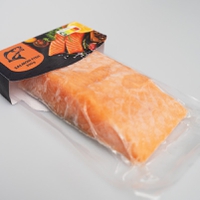
Südpack’s new Multifol Extreme packaging film for fishery products combines maximum functionality and minimum added weight, “breaking new ground,” according to the company.
A high sealing strength and puncture resistance make the film suitable for packaging fatty, protein-rich or sharp-edged products such as fresh or frozen fish like salmon filets, white fish and herring portions. When sealing surfaces are contaminated, the sealing still provides high protection and a low degree of leakage.
The film weighs approximately 20% less than the former version, the Multifol NT — and around 30% less than conventional PA/PE structures commonly used for packaging. These changes mean that the 150‑µm Multifol Extreme film can replace conventional thermoforming films with a thickness of 200 µm — without compromising on product protection, according to the company.
Producers can achieve further material savings by combining a Multifol Extreme base film with a lidding film from the same product family, emphasizes Südpack.
The material efficiency of the film can reduce a company’s consumption of fossil feedstock and carbon footprint. Lighter-weight packages impact the entire logistics chain with additional ecological and economic benefits.
Due to the thinner film, each reel contains more material, which means lower storage and transport costs, and fewer reel changes mean less downtime for the packaging machines.
Optimizing process capability
Fishery products are extremely susceptible to oxidation, notes the company. “Good barrier properties of the packaging concept, especially in terms of oxygen, and excellent mechanical protection are essential to the long shelf life of these high-value foods.”
Multifol Extreme also offers a solution for MAP and vacuum packaging, which provides optimal food protection despite thinner material. Apart from fresh product packaging, the concept is also suitable for extreme-temperature applications such as frozen foods.
We recently spoke to several industry experts about frozen food packaging, who explained that one of the biggest hurdles in producing effective frozen food applications is having the right mechanical strength in combination with easy processability on filling lines.
Südpack’s new development also offers “outstanding” thermoforming properties with large drawing depths and processability on all common thermoforming packaging machines, says the company.
Recently, Südpack expanded its range of sustainable print quality technology to include rotogravure printing (engraving images onto packs), which reduces ink and solvent consumption while optimizing print quality.







